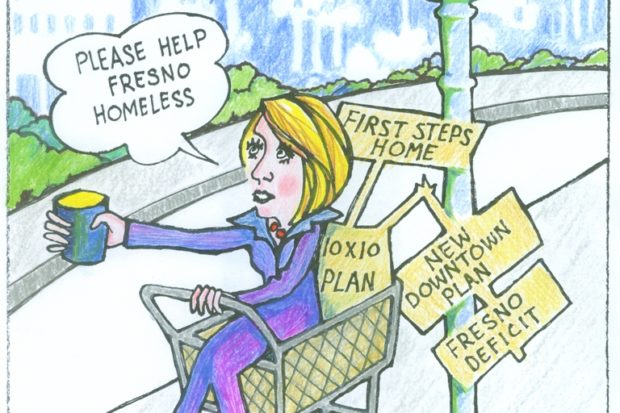

The Community Alliance newspaper has been at the forefront of defending homeless people’s rights and exposing the City of Fresno’s harsh and callous policies regarding the homeless. Our documentation of government abuse of the homeless helped to bring about policy changes at City Hall and a $2.3 million settlement to compensate the homeless for their losses. The lawsuit stopped the city’s policy of bulldozing encampments and destroying homeless people’s property.
In a departure from the usual “From the Editor” format, I will bring Community Alliance readers up to date about the homeless situation in Fresno and attempt to move the discussion about how to end homelessness in this community forward.
Last month, Mayor Ashley Swearengin announced the start of the Fresno First Steps Home initiative, which she and homeless czar Greg Barfield say is a step forward and a reaffirmation of the city’s commitment to end homelessness. What this initiative does is privatize the work to end homelessness by forming a nonprofit 501(c)(3) that will oversee the work. The City of Fresno will dramatically reduce the amount of government funding provided to end homelessness. In previous years, the city has budgeted millions.
Since January of last year, when Swearengin came into office and Barfield was hired as the homeless czar, life for the homeless has not improved. In fact, there are now more homeless than ever and the conditions on the street are worse.
When Barfield started 17 months ago, he told me that official records, from the group set up by the city to develop a 10-year plan to end chronic homelessness, indicated that there were fewer than 1,000 chronically homeless people in Fresno. Barfield said there were a total of 4,267 people who were officially classified as homeless at that time. Many of those classified as homeless were people sleeping on friends’ couches, staying in their cars or living in a garage. The chronically homeless are the people living in tents on the streets, who have been there for a while. In a recent TV interview, Barfield said he thinks there are now about 14,000 homeless in Fresno.
When Swearengin and Barfield started their jobs in January 2009, the city was providing one independent (not connected to a social service agency) homeless encampment with portable toilets and trash bins. Another independent encampment had drinking
water. Those city portable toilets and trash bins are now gone. The access to water at the one encampment is unreliable, having been turned off for several months. It has now been turned back on, but nobody knows for how long. The city has also announced its intention to discontinue funding for the tool sheds at the Poverello House, which provides shelter for more than 100 homeless people.
Last year, the city forced the homeless out of the sprawling H Street encampment (just south of Ventura Street). Many of those displaced homeless people moved to a new encampment on F and Ventura streets. This encampment was shut down, through a court order obtained by the city in January 2010, and the homeless were then chased from one vacant lot to another. Today, there are four major encampments in the downtown area (five if you count the tool shed city at the Poverello House).
Barfield says that the city has helped 395 households with the federal stimulus money it received ($3.4 million over two years). Many of those people received housing vouchers and now have an apartment. The problem is that, given the number of new homeless people on the streets, the city is not even treading water. There are more homeless people on the streets now than when Swearengin and Barfield started their jobs.
The city’s new nonprofit is an attempt to shift the responsibility for funding homeless initiatives from the government to the private sector. This is part of the mayor’s overall goal to balance the budget by privatizing essential government services. She is also trying to turn over parks and recreation facilities to nonprofit organizations to run. This drive toward privatization is a central goal of the right wing’s effort to reduce the size of government by outsourcing services.
On the Fresno First Steps Home Web site (www.fresnofirststepshome.org/?p=186), it says that “a recently completed cost analysis of chronic homelessness in Fresno estimates that housing one chronically homeless person saves $11,872 per person per year in public funds.” I think that figure might be low. But, using their numbers, if you were to get 10,000 of this city’s homeless off the street, the city would save $118,720,000. That is enough money to get the city out of the fiscal crisis it is in and end homelessness. Either the Fresno First Steps Home press release on its Web site is lying or we have figured out how to end homelessness and solve the financial crisis. If you want to end homelessness and save tax dollars-give people housing!
City of Fresno officials will tell you that they don’t have money to put in the budget for initiatives to end homelessness. Yet, they have money to pay attorneys to go to court and evict the homeless, they have money to enforce an ordinance to prevent the homeless from asking for help on median islands and they have money to put up fences around vacant lots all over downtown Fresno (to keep the homeless from camping). And now they are telling us that they are going to privatize any efforts that would actually help the homeless.
City officials are willing to spend our tax dollars on things to make the lives of homeless people more difficult but not on the things that would help them. Also, knowing that they could save more than $11,000 a year on each person who is put into housing, they fail to act. Their policies are hurting the homeless and costing taxpayers more money than necessary.
Astonishingly, city officials attempt to take the moral high ground when confronted with these contradictions. They will tell you that they want to focus on putting homeless people in housing and that homeless advocates should be ashamed of themselves for
encouraging the homeless to live in the deplorable conditions in the encampments.
The deplorable conditions in the encampments are a direct result of the City of Fresno’s neglect and failure to provide even the most basic public services, available to every other resident in this city. The city could easily provide portable toilets, trash bins and drinking water to each of the encampments. The city does not because it wants to garner public outrage at the homeless for living in deplorable conditions.
At this time, homeless advocates, which include many of the homeless, are divided about what to do about the situation. Generally speaking, there are four major tendencies that have emerged over the last couple of years.
Approach A. Some homeless advocates believe that working with the city is the best approach to improving life for the homeless. They argue that the city has the resources needed to end homelessness and that if we could just convince them to do the right thing, life for the homeless would improve. The city does say that it wants to shift away from the shelter model of addressing homelessness and toward a Housing First model. Housing First is a good program that puts people into housing without preconditions and provides them with whatever social services they need to improve their lives.
Homeless advocates supporting this model support the new Fresno First Steps Home initiative. They think the social service organizations are doing what they can to address the situation and that things will improve if we stay the course.
A creative variation on this theme is local architect Art Dyson’s vision of eco-villages. These structures are inexpensive, ecologically sustainable and would house 10-15 homeless people in each village. The idea is to have a nice place for the homeless to live as they transition out of homelessness. Each eco-village would have an economic engine that would develop skills and income for the residents, while they build their resumes and move toward independence. Dyson can probably raise the money and get the supplies needed for the project, but he needs land on which to build the eco-villages.
Approach B. On the other end of the spectrum are homeless advocates who say that the rise in homelessness in Fresno is a clear indication of a failed social and economic system. They don’t want to rely on the dysfunctional local government for help and instead support direct action. About the time of the Ventura and F street evictions, this group created a map of vacant, bank-owned, foreclosed homes and encouraged the homeless to move in. Their argument is that there are plenty of empty buildings and vacant homes in this community and that it is criminal to allow the homeless to die on the street from the heat or the cold when there is plenty of available housing.
Approach C. The largest group of homeless advocates is the folks who are in the trenches serving meals, delivering water and, in one case, paying for portable toilets at the encampments. Rick and Brandon Morse, owners of the Med Mar medical marijuana dispensary, have set up portable toilets and trash bins at several encampments to improve the quality of homeless people’s lives. Food Not Bombs and Catholic Worker provide the homeless with food several days a week.
Approach D. My friend Jeremy Alderson, who is the director of the national Homelessness Marathon heard locally on KFCF 88.1 FM, argues for a new approach to the work. He says we need to build a movement for civil rights for the homeless. This movement would be modeled after the civil rights movement in the South and the United Farm Worker movement, organized right here in the Central Valley. Alderson argues that it will take a social movement of the homeless, homeless advocates and the poor to force the city to move in a direction that respects homeless people’s rights and starts to make progress to end homelessness in this
community.
In this issue of the Community Alliance, we are including an outline of each of these approaches. These articles are written by people directly involved with the work. It is our hope that this dialogue will move us closer to ending homelessness. See: https://fresnoalliance.com/?p=1488
While the homeless and their allies work on the vision for ending homelessness, everyone agrees that the City of Fresno could do a better job than it is doing. An easily achievable first step would be to establish safe and legal campgrounds where the homeless can live. These facilities would be relatively small and spread around the city, where the homeless live already. These campgrounds would have toilets, trash bins and drinking water. Homeless people would be treated with the dignity and respect they deserve and would receive any social services they need to end their homelessness.
After the campgrounds are established, everyone can join together in encouraging the city, one way or another, to provide the homeless with the housing they need. Ending homelessness is not only the right thing to do, but it will also save taxpayers money.

